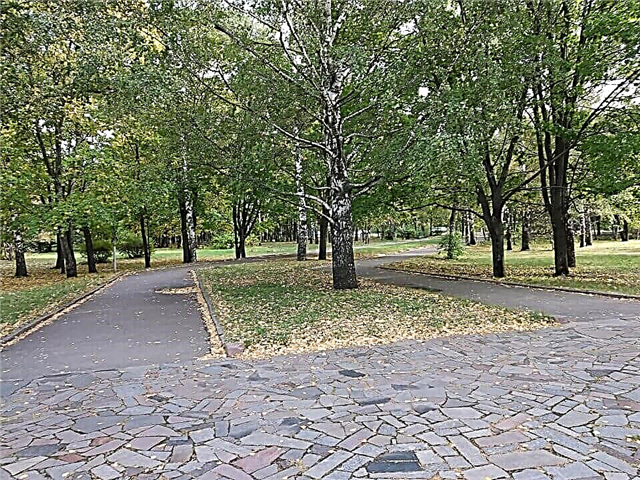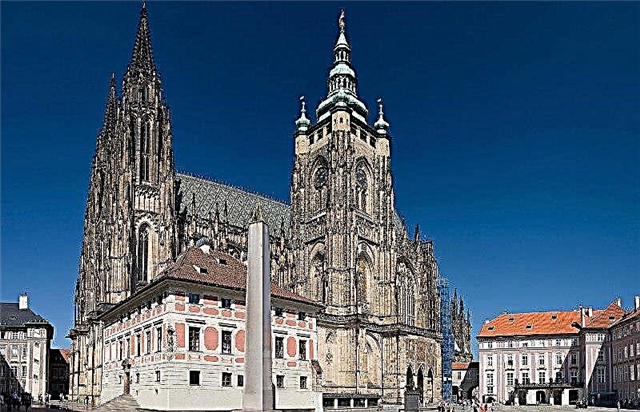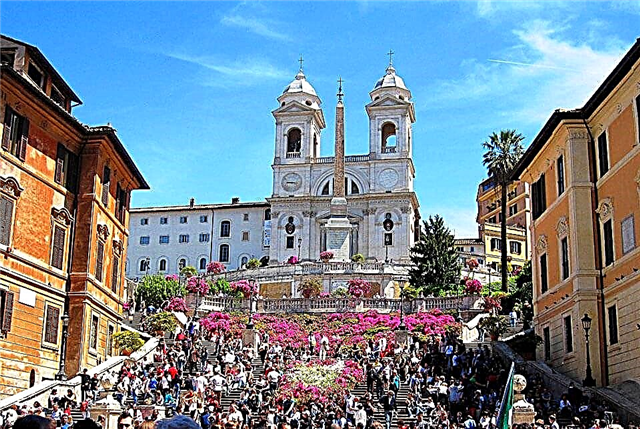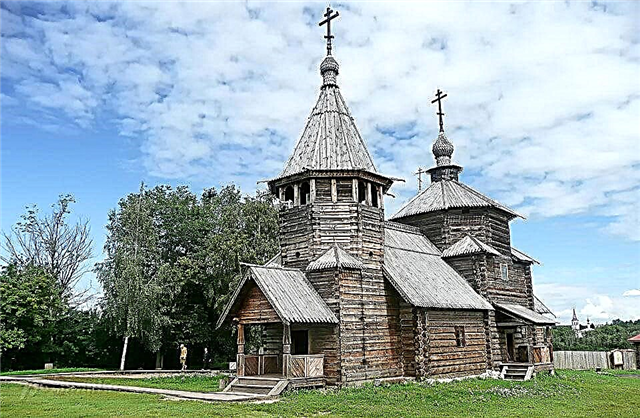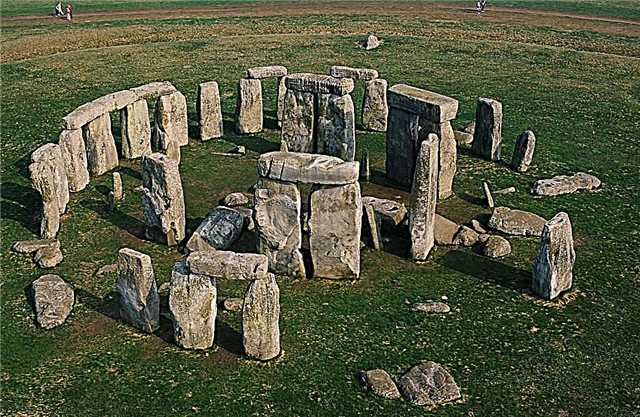Address: Russia, Pskov region, Pskov, Gremyachaya street
Build date: 1525 year
Height: 20 m
Coordinates: 57 ° 49'23.6 "N 28 ° 20'55.1" E
Content:
1.5 km from the mouth of the Pskova, on the right bank of the river rises a round tower with loopholes. In appearance, the gray Gremyachya Tower resembles ancient fortresses that were built in European cities in the Middle Ages. And this impression is not deceiving! Historians believe that the tower could have been erected by a native of Italy, Gian Batista della Volpe, who was nicknamed Ivan Fryazin in service in Russia.

View of the tower from the opposite side of the Pskov River
Tower history
The old tower is located in an interesting place - on the elevated right bank of Pskova, which is commonly called Gremyachya Gora. There are two versions why the mountain was called "Gremyachaya". According to one of them, this name appeared because of the keys hitting at the foot of the hill, which appeared from a thunderclap. According to another assumption, the mountain became "Gremyachaya" because of the many forges that stood here in the Middle Ages.
The exact time of the tower's construction is not known. Most likely, this happened in the 15th or 16th century. Historians managed to find an entry in the Pskov chronicles from 1525, in which Prince Vasily Ivanovich ordered to erect a stone tower over the Pskov tower and make a cache in it. In those days, the tower was called "Kosmodemyanskaya" by the adjacent church. And the name "Gremyachya" belonged to another fortification located above the Gremyachya Gate. It was destroyed in the 19th century, and after that the Kosmodemyansky fort began to be called "Gremyachy".
In the Middle Ages, a section of the fortress wall was thrown from the tower across the river, on which there were four curved arched gates for the passage of boats through Pskov. If the city was in danger, the passages under the arches were closed with strong forged gratings, and the enemy was deprived of the opportunity to move on the water.

View of the tower from the Finnish Park
On the opposite bank of the river stood the Nikolskaya Tower, built in the 16th century. It has not survived to this day. However, a small fragment of the old fortress wall can be seen on the left bank of the Pskova, 50-100 m from the river, on Militsa Street.
The Gremyachya Tower was covered with a cone-shaped wooden tent up to 15 m high. In addition, there was a podlaz in the direction of the river. This was the name of the stone tunnel, through which the defenders of the Okolny town, during the sieges, descended to Pskov to take water. Thus, the powerful tower performed not only fortification functions, but was used for the intake of river water, saving the inhabitants of the city from thirst.
The Gremyachya Tower has features unusual for Pskov architecture. The limestone blocks used for its construction were hewn with great care. The fort has an intricate system of entrances, atypical loopholes and an elaborate domed vault. All these signs suggest that the Italian diplomat and architect Ivan Fryazin - Gian Batista della Volpe, who was in the Russian service in the 15th century, may have been involved in the construction of the tower. It is curious that in Medieval Russia the Franks were called "Fryazins" - immigrants from Southern Europe. They were mostly Italians.

Tower view from the west
Ancient legend
Several folk legends are associated with the old tower. Like any legends, they contain only part of the historical truth. Such legends appear not to copy chronicles, but to convey the attitude of local residents to a historical or natural attraction.
One of the legends tells how the Teutons who lived to the west of Pskov wanted to take possession of the city many times. The enemies made several attempts, and once they managed to capture the Pskov prince. By order of the master of the order, the Teutons built a high tower on the banks of the river and imprisoned a noble prisoner in it. The prince, chained in cast-iron chains, did not lose heart and many times turned to the inhabitants of the city through the loophole, urging them to rebel against the enemy.
The ruler of the Teutons learned about this and ordered to secretly kill the rebellious prince. But even the death of the leader could not stop the Pskovites. With weapons in hand, they marched against the enemy, and in the midst of the battle they saw the shadow of their prince over the tower. Unable to withstand the pressure of the Pskovites, the Teutons fled. The dead townspeople were buried at the foot of the tower, the body of the prince was never found. After a while, every year on the day of his death, the inhabitants began to hear the calling sounds of the bell, so the tower was named "Gremyachaya".

Tower view from the south
Temple of Cosmas and Damian
40 m west of the tower, on the green slope of Gremyachy Mountain, there is the Church of Kosma and Damian. The history of the one-domed temple begins in the second half of the XIV century. In 1363, this church was first mentioned in the Pskov chronicles. In the Middle Ages, blacksmiths lived at the foot of Gremyachaya Mountain, so the temple was consecrated in honor of the unmercenaries Kosma and Damian, who were considered the patrons of blacksmithing.
In those days, the church was assigned to the Kosmodemyansky (Gremyatsky) monastery. This monastery is known for the fact that in 1664 the Archbishop of Pskov and Izborsk Macarius took up the schema and settled here. A year later, Vladyka died and was buried in the monastery cemetery. In the 60s of the 18th century, during the church reform carried out by Catherine II, the old monastery on Gremyachaya Gora was abolished, and the church became a parish church. But the parishioners were few, so she was assigned to the Church of Peter and Paul, which stands on the opposite, left bank of the Pskov.
At the beginning of the 19th century, they wanted to demolish the temple because of its dilapidation. Church services were stopped due to the possible collapse of the building, but the Holy Synod decided to preserve the church.

Church of Kosma and Damian and the Gremyachaya Tower
In 1850, long-awaited changes came for the Kosmodemyanskiy temple. Pskov merchant P.M. Stekhnovsky repaired it at his own expense and made rich donations for the church. After the arrival of Soviet power, the church building was transferred to the Pskov city museum, and during the Great Patriotic War, a stable was placed inside it.
Today the church is active and has the status of a historical and cultural monument of federal significance. The temple was built from Pskov limestone. It is a three-absid quadrangle with a narthex, in which three ancient doorways have been preserved. A deaf drum with a small dome rises above the roof.
State of the art
The medieval six-tiered fort has been perfectly preserved, although time has left its inexorable mark on its walls. The Gremyachya Tower was built on an artificially leveled rock ledge, which served at the same time as the foundation of the entire structure and the floor for the lower tier. The tower rises to a height of 20 m and reaches a diameter of 15 m at the ground. Interestingly, the thickness of the walls at the bottom of the fortification reaches 5 m, which means that the fort was very strong and posed a serious threat to the enemy.

View of the tower from the Church of Cosmas and Damian
The round tower has 28 loopholes or embrasures. In the old days, tiers were separated from each other by wooden floors on which the cannons stood. Thanks to the well-planned space, a whole garrison of soldiers could be accommodated here. Today, complete desolation reigns inside the Gremyachaya Tower.
There are no residential buildings around the fortification, and a powerful tower built on a hill dominates the area, towering over the right bank of Pskova. The river bed in this section is not wide - about 30 m, the banks are overgrown with bushes and trees, and therefore the old tower looks very picturesque.
At the base of the medieval building there is a dilapidated arch. If you go through it, you can go to the bank of Pskova. From the river one gets the impression that the old tower seems to grow out of a limestone rock and serves as the foundation for the entire Gremyachaya Mountain. The place is extraordinary and many people come here.At any time of the year, near the tower you can see the people of Pskov walking and tourists who have come to admire the medieval stronghold.
From the south of Gremyachaya street, a fragment of the fortress wall of the Okolnichego city with a length of 300 m has been preserved. The low wall starts from the tower and ends near the intersection of Gremyachaya street with Herzen street. It is composed of small blocks of limestone and is dilapidated in places.

View of the tower from Gremyachaya street
How to get there
From the territory of the Pskov Kremlin, a walk to the Gremyacha Tower takes about 20 minutes (1.5 km). The tower can be reached by buses No. 3 and 5, as well as by route taxis No. 51 and 51A. From the Ippodromnaya Ulitsa stop to the old fort, 0.6 km on foot along Gremyachaya Street. Another option is to get to the tower from the side of the Velikaya River by buses No. 5, 11, 22 and 30. From the Ulitsa Truda stop to the tower, you need to walk along Shkolnaya and Gremyachya streets (0.9 km).
For those who travel by car, from the southeastern outskirts of Pskov, you need to turn off the Leningradskoe highway onto the A 212 highway leading to Izborsk, and go along it to the city center. Then you need to cross the Pskov River along the Troitsky Bridge and turn right into Herzen Street. From here to the tower about 1 km of the way along the streets of Herzen and Gremyacha.

